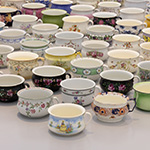Spike Island presents Grey Unpleasant Land, a collaborative exhibition by artists Sophia Al-Maria and Lydia Ourahmane.
Grey Unpleasant Land examines the myth of England as a nation. Combining historical artefacts, speculative narratives, petitions to patrons and a deed of gift, Al-Maria and Ourahmane provide a unique lens through which to investigate the complex and often troubling nature of England’s cultural and historical landscape.
Produced over the course of two years, Al-Maria and Ourahmane delve into the “grey areas” of England’s narrative from their position as immigrants to the UK, critically re-examining the stories that have been told — and continue to be told — about origins and belonging.
Central to the exhibition are the works Job Lot (late 1700s/2024) and Silver Service (1774/2024), presented as a diptych. The two sets of found objects explore the notion of inheritance as represented through the possessions of two living members of very different English families. Graham Randles, the son of Liverpool pub owners, inherited 240 chamber pots, which were originally collected from auctions, markets and car boot sales to decorate the pub ceiling. These sit alongside Sir William Bellingham’s inheritance of George III silver, a 250-year-old collection stored in heavy trunks and recently retrieved from the vault of a NatWest bank in Stockport. The diptych is set to go to auction in 2025.
In Birthright (2024), a pallet of Scottish sandstone weighing over one tonne hailing from the same geological seam as the Stone of Scone – an ancient and historically significant symbol of Scottish and English monarchy – questions the legitimacy of those who are born to rule. Alongside it, A Blessing and a Betrayal (2024), a medieval stained-glass diptych, reimagines the biblical story of twin brothers Esau and Jacob. Depicting betrayal, sibling rivalry and territorial claims, the work reproduces an AI-generated text that offers an account of Esau’s imaginary dream after his brother’s betrayal.
Framing Device I showcases display fittings associated with a seminal icon of pre-Reformation England: the Wilton Diptych (c. 1395–1399). Created by an unknown artist and preserved by an unknown patron, the diptych is remarkable for its survival. The carrying frame, support frame and handling frame presented here, provided by the National Gallery–which acquired the work in 1929–have been instrumental in its preservation and display.
Themes of ownership and class are explored in the works Fly Tip (2024), a series of scavenged possessions illegally dumped in and around Bristol containing contaminants, vacuum-sealed in purpose-built aluminium bags and Curtain (2024), a drape retrieved from the bin outside 44 Kinnerton Street, Belgravia in 2020, as the mews house was undergoing estate clearance. With its imperial red velvet, the curtain serves as a witness to the moral decay of England’s ruling classes.
Ahead of the exhibition, on 14th September 2024, Al-Maria and Ourahmane placedan advertisement (Terra Nullius, 2024) in The Spectator Magazine (Vol. 356, Issue 10, 229) seeking landed gentry. The title refers to “nobody’s land” or a “territory without a master” – a term used in public international law to describe a space that can be inhabited but does not belong to any state. Through the advert, the artists wish to engage in conversation with landowners, encouraging them to gift symbolic amounts of land across the country – not to a body but to nobody. This endeavour introduces a legal conundrum, as there is currently no framework for the formal disowning of land.
Together through this ambitious exhibition, Al-Maria and Ourahmane address England’s cultural narratives and social frameworks, inviting audiences to consider the malleability of national identity and the ongoing debates surrounding Britain’s legacy as a nation.
Press release from Spike Island
Image: Sophia Al-Maria and Lydia Ourahmane. Job Lot. Late 1700s – 2024. Detail. 240 hand-painted chamber pots. Installation view of Grey Unpleasant Land at Spike Island, Bristol, 2024. Photography by Rob Harris



